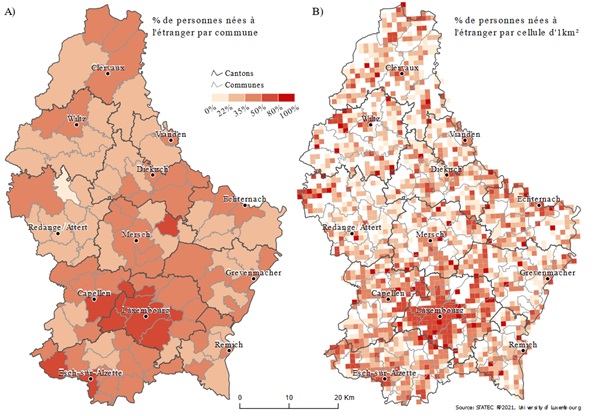 Credit: Statec
Credit: Statec
Statec, Luxembourg's national statistic office, has published a report on geographical distribution of immigrants in Luxembourg entitled "Dynamics and spatial segregation with natives".
Across the country, the presence of residents born abroad is significant, with an average share of 49.3% of the total population during the 2021 census. However, variations at the municipal level range up to three times different. The location of immigrants depends both on their origin and the duration of their stay in Luxembourg.
Geographic distribution of the immigrant population as a whole
Different maps illustrate the proportion of the immigrant population in each municipality (A) and in each 1 km² cell (B). Map 1.A shows that all Luxembourg municipalities face a relatively large presence of non-native populations, which distinguishes Luxembourg from other European countries. There is nevertheless a significant variation in the share of immigrants in the municipal population. The highest proportions are observed in the two most populous cities in the country, namely Luxembourg (72.7% immigrants) and Esch-sur-Alzette (56.1%), as well as in around ten municipalities close to the capital.
Using the data available per 1 km² cell (map 1.B) makes it possible to considerably refine the analysis of exposure to immigration and diversity. Firstly, it reveals that the geographical location of immigrants is more concentrated than the analysis by municipality suggests. Secondly, it allows us to illustrate the significant variation in the share of immigrants within the municipalities themselves. These cells with high migratory intensity are concentrated in certain neighbourhoods and near the capital as well as along the borders, which does not appear as clearly at the municipal level.
A heterogeneous distribution according to origins
1. Analysis by country of origin:
The proportion of immigrants from neighbouring countries constitutes 12.9% of the resident population, of which 54% are from France, 26% from Belgium and 20% from Germany. This immigration is concentrated mainly around the city of Luxembourg and in border areas close to the countries of origin. Ten municipalities have proportions above 18%. These include Luxembourg (21.4%), Kopstal (20.0%), Strassen (19.9%), Habscht (18.3%), Hesperange (18.2%), and Steinfort (18.1%).
Residents born in France are mainly established in this central region as well as in the southern region of the country. A more in-depth examination of this population indicates that its location remains stable over time, little influenced by the length of stay.
Other inhabitants of neighbouring countries, mainly those born in Belgium, are strongly present along the border in the north of the country. In comparison, people born in Germany represent a lower proportion of populations bordering Germany.
Residents born in Portugal represent 11.3% of the total population, constituting the largest community since the 1980s. Immigration of Portuguese workers began in the 1950s, mainly clandestinely, before being regulated from early 1970s.
People of Portuguese origin represent a relatively small share of the population of the Central region. They are more concentrated in the south of the country, in the canton of Esch-sur-Alzette, and in the northeast, in the cantons of Vianden, Diekirch, Echternach, as well as in the surroundings of Larochette. Their presence in the northeast was already significant in 1991, two decades after the signing of migration agreements between the two countries. On the other hand, the presence in the south has gradually increased.
Immigrants born in the rest of the European Union constitute the smallest group, representing 9.6% of the total population. Since the 1980s, this influx of European labour has responded in particular to the development of international services, such as banks or European institutions. This immigration is mainly concentrated around the city of Luxembourg.
Finally, immigrants born outside the European Union represent 15.5% of the total population and form the group experiencing the strongest growth in recent decades.
This growth reflects the diversification of immigration to Luxembourg, with significant influxes from a few countries such as China, Montenegro, India, Cape Verde, Kosovo, Brazil, Russia, Morocco or Turkey.
In addition, for several years, Luxembourg has been one of the OECD countries which receives relatively the most asylum seekers per capita, in second place after Greece. These non-European immigrants are mainly located in three cities in the country – namely Luxembourg, Esch-sur-Alzette and Wiltz – and their outskirts.
2. Analysis by length of stay:
The city of Luxembourg has a significant share of 31.6% of very recently arrived immigrants in its total population, which suggests the role of “gateway” played by the capital for newcomers.
However, the share of immigrants who arrived more than 20 years ago is only 10% in the capital, less than in neighbouring municipalities, those in the south, as well as in the corridor going towards Nordstad.
Distribution of the population by type of urbanisation and by length of stay in Luxembourg
The locations can be grouped into three categories: the urban centre, in this case the city of Luxembourg and its outskirts, the urban clusters where there are 300 people per km² and more than 5,000 inhabitants and finally the rural areas with density lesser.
While natives of Luxembourg are in the majority in rural areas (63.2%), their proportion is close to that of immigrants in urban clusters (53.2%), but is largely in the minority in the urban centre of Luxembourg (30.2%).
For their part, the Portuguese community and immigrants present for more than 20 years display the highest proportions in urban clusters. For all other immigrant groups, the largest shares are observed in the urban center made up of the capital and its periphery.
Furthermore, it is also interesting to note that location disparities systematically decrease with length of stay. The differences in location of long-time residents are much smaller than that of newcomers. Again, this phenomenon can be naturally explained by the fact that the length of stay favours integration.








